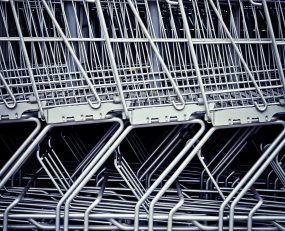
With the outbreak of COVID-19 and its rapid spread around the world, economies have practically ground to a halt with extremely mixed results for retailers. While presenting a whole spectrum of experiences, grocery retailers have moved centre stage during this period as there has been a remarkable surge in demand, particularly leading up to the full lockdown in the UK and around the world. This surge frequently led to comparisons in demand that is “on par with Easter or Christmas”, which was also reiterated by Helen Dickinson, chief executive of the British Retail Consortium, during a daily press briefing in March, stating that the industry was experiencing “a peak in demand like Christmas, without the four-month build-up period”. These comparisons suggest a similar if not direct application of a strategy designed for periods where grocers usually experience a notable spike in consumption.
Demand increase is perhaps all there is to the comparison, as the peak came with no warning, thus no preparation and planning, lasted longer and not to mention the complete lack of the joyous Christmas spirit. Instead of dashing through the snow, customers were rushing to supermarkets to panic-buy and stock up on basics such as toilet paper, canned foods and whatever else was left on the heavily depleted shelves.
While employing some peak season strategies and tactics seems like an appropriate solution in response to the sudden spike in demand, as a solution it will only really be useful in the short-term, as it is designed to be, and will not serve the grocers in the long-term as it is bound to reach its limits.
Plan & Prep
Typically, a long and comprehensive preparation and planning period precedes the arrival of peak season, as mentioned above, and is supported by technologies analysing consumer behaviour to feed it back into predictive systems. These systems, which usually even factor in weather and sporting events to predict consumer behaviour were obviously caught off-guard – much like the rest of the world. With the pandemic, there was neither a preparation period nor was consumer behaviour predictable any longer. The UK supermarket industry reported its best month on record with an extra spending of £1.9bn on supplies in March, overall sales going up by 20.6% within four weeks, leading to figures “busier than Christmas” said one manager, but who continued “but obviously Christmas is fully planned and we have ‘pulled forward’ stock so core items are stored on-site to help the delivery network”. Many grocers soon introduced measures to cope with the unprecedented levels of demand by rationing items and reducing SKUs to focus on core product lines. This had the knock-on effect of freeing up production capacity at suppliers, which could be refocused on those same core products. In addition, many supermarkets rapidly employed extra staff and some even sourced goods intended for the catering industry, which had ground to a halt.
Stock
During those peak seasons supermarkets will also use all available space in the stores, with stock piling up above shelves, in backrooms, and in trailers outside the stores. The pandemic has exposed major vulnerabilities of its supply chain during this time of heightened demand, with continuous knock-on effects; “distribution centres are running low on stock because retailers are ordering more into their stores. But they can’t get more stock into the distribution centres because they can’t transport it into the supermarkets fast enough. All the while the shelves are rapidly emptying, and the supermarkets don’t have enough backroom space to store it all”. Even though product availability was there, the capacity to delivery was not.
Online
As part of the preparation for peak-season, grocers also ramp up their online presence in order to ensure smooth and swift consumer experiences. During the pandemic, however, even grocers that only have an online presence were forced to suspend their websites in order to keep up with incoming orders, such as Ocado, were swamped with orders creating virtual queues with next available slots several weeks away. Online capacities have been particularly strained and unable to meet demand, prompting major companies to urge customers to shop in stores where possible. With the average basket size doubling and Ocado reaching order figures that compare to entire annual results for just Q1 2020, it became clear that facilities had not been able to increase capacities in time.
Moreover, according to analysts at Bernstein, it is also not very cost-efficient for supermarkets to fulfil online orders from existing stores. Labour costs for home deliveries that are picked in-store are around 15-20% of revenue, whereas it is only 11-13% for physical stores, i.e. making it easier for stores to increase capacity by adding people. As the situation unfolded, grocers started adding several thousand pickers and drivers to support their operations and began to slowly adapt to the circumstances, even though online orders are still lagging.
Given the unprecedented nature of the pandemic creating dynamics that have not and could not have been prepared for the best strategy will be to remain as agile as possible and more so than before. With restaurants closed an extra 500m meals and snacks will be consumed from home, meaning there is a lot of opportunity involved for grocers around the world, as customers have been spending 25.5% more on foodstuffs since the outbreak of the pandemic. However, the volatility and uncertainty of the situation calls for scalability of temporarily implemented measures that are flexible enough to adjust to a rapidly changing environment.
Source: Transport Intelligence, April 21, 2020